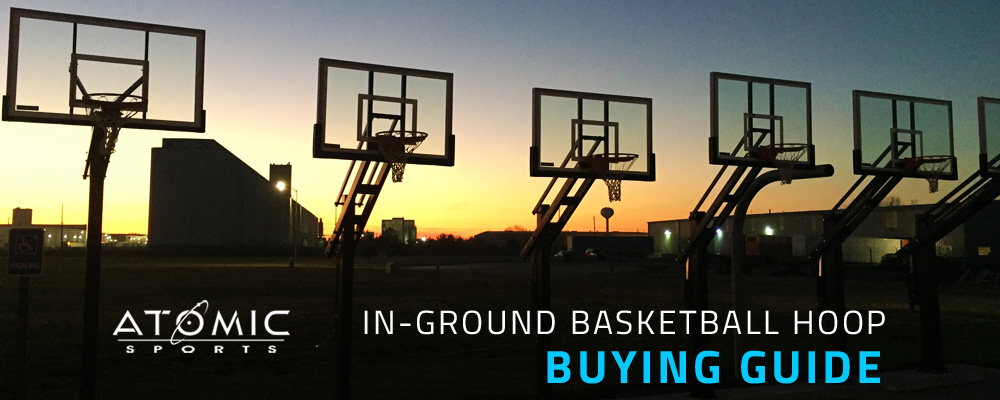
In-Ground Basketball Hoop Buying Guide
What you should know before buying a basketball goal
If you are thinking about purchasing a new goal, the options can be overwhelming. You may be unfamiliar with certain hoop features or unsure of your needs. Our comprehensive guide aims to explains goal components, features and other considerations to take into account when purchasing a new basketball goal online or at a big box retailer.
Portable vs. In-Ground Basketball Goals
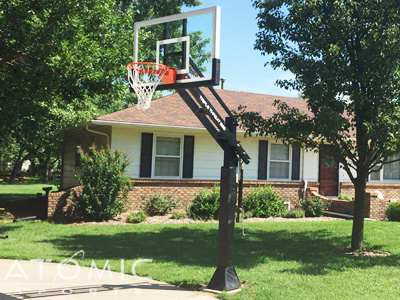
Portable systems generally have wheels or a base for portability and sometimes offer an adjustability option. These hoops may be versatile, however, the systems generally sold for residential use are not well-suited for aggressive play or serious ball players. Due to the lightweight design of most residential portable basketball goals, ball bounce off the backboard suffers greatly and hanging from the rim is strongly discouraged as well. The value you receive from an investment in a portable goal is much less than from a heavy duty in-ground system.
A heavy duty in-ground basketball hoop provides the most stability for players, since the pole is connected to a concrete footing installed in the ground. This type of installation is typically accomplished by bolting the post to anchor bolts imbedded in the concrete footing. This type of installation is both rigid and stable yet provides the flexibility needed to allow you to unbolt the post and relocate the goal if you sell your house and want to move it to a new home. An in-ground goal is the best choice for any individual wanting the greatest basketball experience at home.
Backboard specifications
Backboard Size
Backboards come in many different sizes. Most common are:
54” Wide
This is a great size for those with little space or a smaller budget and is ideal for a 1-car driveway or small court.
60” wide
If you have a larger driveway or court, a 60” basketball goal provides a great playing experience while not taking up too much room.
72” wide
Regulation-sized hoops are well-suited for large driveways and courts. If you are a serious player and have the space, there is simply no substitute for practicing with a regulation hoop.
Surface Area vs. Aesthetic Preference
In the end, don't get hung up on backboard size. For a goal to impede your ability to shoot back shots, you would have to go smaller than 48" wide. Keep in mind, it wasn't that long ago that most high schools were still playing games on small, fan-shaped backboards. Regardless of size, most reputable companies manufacture their backboards with a regulation size shooter’s square (target) printed on the backboard. The official size for a shooter's square is a 24" wide x 18" tall x 2" wide stripe. Do not buy a goal if it does not have the proper size of shooter's square printed on the backboard. Since most bank shots taken on the court are shot at the shooter's square, your backboard size decision should be based more on your personal aesthetic preference than concern over surface area. Aesthetically, 54" backboards have a square look. Sixty inch backboards are rectangular in shape like an official 72" backboard.
BackBoard Support System
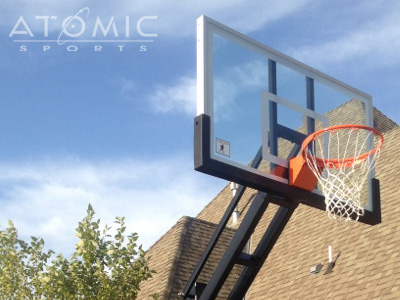
A good support system is necessary for the longevity of your basketball goal. Ironclad backboards use one of two direct rim mounting support concepts.
H-Frame
H-Frame supported backboards are the strongest. They employ a steel "H" visible behind the glass generally positioned behind the shooter's square. Choose a model that uses this style of backboard support if you anticipate a lot of hard core hanging on the rim. The H frame style support is the most likely to never fail.
Clear View
Clear View perimeter support provides a durable, clean look with no obstruction behind the glass. This backboard support integrates the rim support into a steel perimeter frame that runs aroud the outer edge of the backboard behind the glass. This style is also very durable and can withstand dunking and hanging on the rim.
Backboard Material
Acrylic
Acrylic backboards, although intended to mimic the look of glass, can become scratched and scuffed over time. These backboards are also lighter and less dense, which means less ball bounce.
Tempered Glass
Tempered glass is the same material you windshield in your vehicle is made of. Glass backboards are the highest quality backboards and are what you will find on a high school, college or NBA court. Tempered glass resists scratching and fading even in outdoor driveway and court installations. It is also heavier, which prevents movement throughout the system during play. Tempered glass is unaffected by extreme cold and heat and can withstand high winds. Weather is not an issue for tempered glass.
Backboard Thickness
The thickness of the backboard is important because a thicker backboard indicates a sturdier and heavier backboard which translates to better ball bounce of the glass. Ironclad basketball goals come with a ½” thick tempered glass backboard that is encased in an aluminum frame, just like competition-grade goals. The only exception is the Gamechanger models, which are intended to be less expensive, entry-level hoops and use 1/4" - 5/16" glass.
Rim and Net
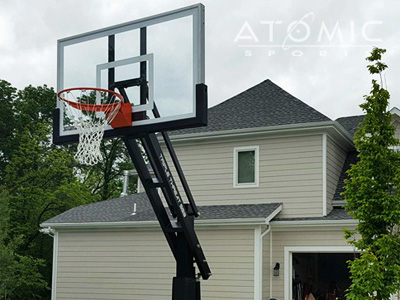
A high-end goal should come with a breakaway rim.
Be wary of "3 spring rims" sold by some competitors, as these rims are designed to be used indoors only. The third spring is a spring encased in what is called a detent mechanism inside the "box" that contains the two return springs which regulates the breakaway pressure for rims used during sanctioned indoor competition basketball games. When used outdoors the detent mechanism tends to rust, when this happens, the rim will no longer breakaway.
Ironclad rims are heavy duty flex rims that use maintenance free 2 spring design. Ironclad rims are made from the same 3/16" thick steel construction competition rims are made of.
Ironclad rim's are attached to the backboard using a "direct" rim attachment. This means that the backboard is designed so the rim does not put pressure on the glass when a player hangs on the rim. The glass is cut out in the areas where the rim bolts pass through allowing the rim to be connected to and supported by the support structure behind the glass. In addition, the rim uses return springs to dampen the force of a dunk. When a player dunks or hangs in the rim, it will flex down 15-20 degrees and the spring up when the player lets go.
Another consideration is the net attachment method. Stay away from rims designed to connect the net using a wire that slides through a series of hollow tubes. Again, this design was originally intended to prevent the possibility of net detachment during sanctioned games to prevent game stoppage to fix the net. This design however can cause nets to prematurely "cut through" especially in outdoor applications. Ironclad goals use time tested "pigtail" formed wire that holds the net. This designed has been used for 50 years, is safe for players’ hands and won't cut the net.
Basketball Hoop Pole
Round Poles
round poles that are often found with portable systems lack stability and the ability to absorb impact. These poles are typically made from steel less than 1/8" thick. Such thin steel can rust through in just a few short years. To make matters worse, these thin posts are usually made from several sections that stack on top of one another. The joints where these sectional posts come together have a tendency to become loose over time, causing the parts to run against each other. This wears away the paint causing rust which causes the post to become more unstable. Without maintenance, this vicious cycle can continue until post ultimately fails.
Square Poles
a square pole design reduces vibration and shaking of the basketball goal and provides the best support for heavier, glass backboards. Pole thickness of 11 gauge or heavier will provide maximum stability and a post that will not rust through. For larger units carrying heavier backboards, 7 gauge (3/16") wall tubing is best. Some competitors provide heavier wall thickness on posts, but this merely adds to the difficulty during assembly and does little in the way of improving the performance of a basketball goal. Heavy duty basketball posts sizes typically fall into four categories: 5”x5”, 6”x6”, 6”x8”, and 8”x8”.
Pole Thickness
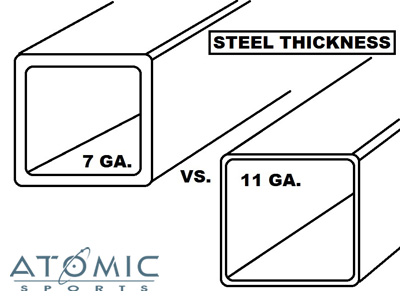
Typically, sporting goods stores carry goals manufactured from 14-16 gauge steel (which is roughly 1/16” thick). Ironclad goals feature 7 gauge steel, which is 3x thicker than many comparable big box store models. This excludes Gamechanger models, which are intended to be an entry-level goal.
Anchoring System
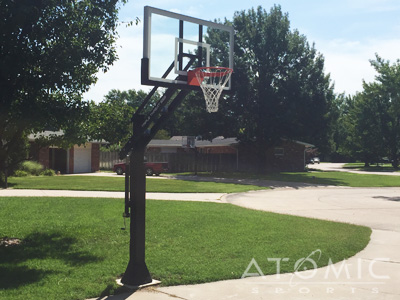
High-end basketball systems for the driveway or backyard should employ an anchor system. An anchor system allows the post to be bolted to a concrete footing rather than cementing the post in the ground. This will allow you to unbolt the goal from the ground and take it with you if you move. A typical anchor system is comprised of a series of four to six threaded anchor bolts embedded into a poured concrete footing. Four sticks of steel reinforcing bar are also supplied to reinforce the concrete. A template is used to ensure exact, proper spacing of anchor bolts. All equipment needed, anchor bolts, rebar, template and nuts come included with every Ironclad basketball system.
Rust Prevention
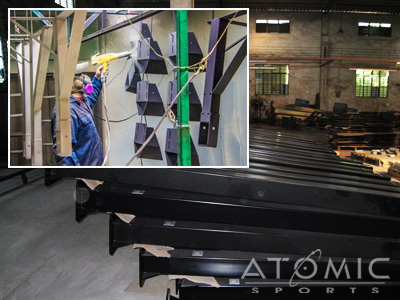
Preventing rust on your basketball goal is crucial. Though this may be accomplished by periodically checking over the system and touching up any trouble spots with touch up paint, Ironclad takes the worry out by providing a rust proof undercoat on the steel prior to painting the steel components on all Triple Threat, Fullcourt an Highlight Hoops in ground basketball goals. The post is first dipped into a bath of molten zinc which penetrates the surface metal creating a rust proof barrier. The parts are run through the powder coat line to give it an aesthetically pleasing look and additional rust protection.
Backboard and Pole Padding
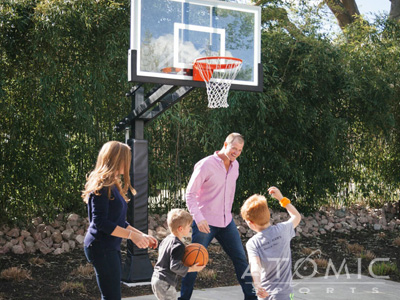
Safety is important. Most Ironclad basketball goals include backboard and post padding to protect against player contact with the goal.
Backboard padding
on an adjustable goal will prevent players from injuring their heads at a low adjustment height if they come into contact with the backboard. Don't forget, adjustable basketball goals such as Ironclad's offer an adjustment range as low as 5 feet. Backboard padding will protect even the unsuspecting passerby who may not be looking where he/she is walking.
Pole padding
prevents injury if a player collides with the pole during a layup or other move. Ironclad post padding is thick and protective. Don't be fooled by competitors who offer thin, so called safety post pads. They won't provide the protection you will want when you need it most. Stick with higher quality thick padding provided by Ironclad Sports.
Height-Adjustment
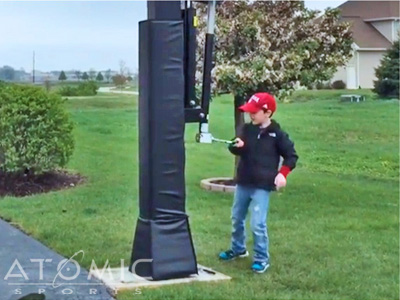
The most common height-adjustment ranges for basketball hoops are from 10’ to 7.5 feet, with higher-end goals adjusting down to 5’. Each adjustable goal also utilizes some kind of mechanism to raise and lower the goal. If you have young children, choosing a goal that lowers down for them to practice allows them the benefit of shooting with proper form to get the ball to the rim. This will reinforce proper shooting habits as they grow.
Spring Assisted
If you buy a crank adjustable basketball goal, make sure it has this feature. Ironclad engineers invented this feature and it has become the standard in the industry for EZ cranking basketball goals. This feature will make your basketball goal adjust upward just as easily as downward. The spring assist cylinder takes the load off the adjustment crank making it possible to easily turn for any age child. This feature will also minimize wear and tear on the adjustment actuator itself giving it long life.
Locking Mechanism
Sometimes you want to prevent unwanted or unauthorized rim height adjustments. Ironclad makes solving this problem a snap. Each Ironclad basketball goal includes a quick release removable crank handle. Simply pull the pin to remove the handle. The pin is lashed to the adjustment crank to prevent loss.
Learn more about Ironclad's spring assisted adjustment feature.
Other Considerations
Overhang or Extension
The overhang
or extension is the distance between the face of the backboard and the face of
the pole. This distance is generally
measured when the rim is at 10'. On a
regulation basketball court, the distance from the baseline to the face of the
backboard is 4 feet. If a regulation
striped court is what you want then you will need to choose a basketball goal with
a 4-5 foot overhang. This will allow you
basketball court to be striped with the same amount of space between the
backboard and out of bounds line (baseline) as a regulation court. This gives players the room needed to
practice post moves and drive under the basket. Shorter courts or tighter playing spaces can benefit from units that
provide shorter 2-3 foot overhangs. The
court striping on these courts should be altered to compensate for the shorter
overhang only, all other aspects of the court striping will remain
"regulation."
Location and Play Area
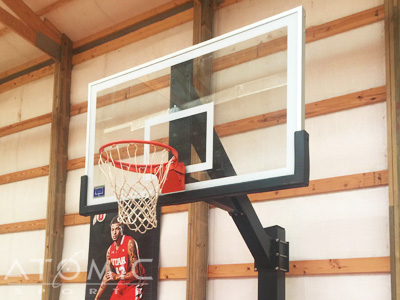
To correctly determine which size of basketball goal to purchase, you should assess your playing space. This starts with the question: "How big is your playing area?" Most customers want the basketball backboard size to match the relative size of the court or other playing area. If you are planning to install the hoop in your driveway, typically you will choose from any of the units with 54" or 60" backboards. If your driveway is exceptionally large such as a three car drive, you could choose to go with a 72" wide backboard.
If your plan is to build a dedicated basketball court or patio, size again is the most common consideration. A patio or court smaller than a "half court" (roughly 50' wide x 40' deep) then you will most likely want to focus on 54" or 60" wide backboards. Regulation high school basketball court is 50' wide x 84' long. College and NBA courts are 50' wide x 94' long. So if you are planning a half to full size court, 72" wide backboards (regulation size) are the typical go-to here.
One additional note about planning the footing location for your basketball goal. Choose an area free of vegetation to mount the goal. Never allow plants or other organic material to live and grow in and around the anchor bolts and post. Vegetation can cause long term damage to your structure and should be kept away from the basketball goal.
Installation Services
Atomic Sports provides an basketball goal Installer Directory for your reference if you choose to employ a professional to install your basketball hoop. Keep in mind this list is for reference only. You are not required to use any of the services shown. The list of operators is for your convenience and is maintained by Atomic Sports. The installers listed retain their listing by having no unresolved issues with customers. However, the list is not an endorsement of their services or guarantee of quality. Please keep in mind the installation of your basketball goal is an agreement between you and the installer, not Atomic Sports.
Big Box Stores vs. Other Retailers
When buying a basketball goal online you should locate a retailer that offers free shipping and provides helpful installation details. Since selling online eliminates most of the overhead costs of a brick and mortar retailer, you can expect more "dunk for your dollar" when buying from a company like Atomic Sports.
Our business model allows us to bring to you heavier duty, better performing basketball systems than chain stores. Even more value is extended when you consider that Atomic Sports will charge no sales tax on your purchase (except for Kansas residents). This can amount to more than $100 in extra savings vs. so called "Big Box" chain sporting goods stores. In addition to more basketball system for your dollar, you will also receive better service and exceptional knowledge before, during and after the sale.
You should also consider the retailer’s knowledge of goals. Basketball goals is what we do at Atomic Sports. We can provide the guidance you need to help you choose the best model for your home and your family, every time! Additionally, we will ship your hoop straight to your home or wherever you prefer to receive the shipment. No need to find a truck and load up heavy boxes at the store. Let us show you why Atomic Sports is America's number one choice for the best in premium residential basketball systems.
Questions or Comments? Leave a reply below. Your email address will not be displayed publicly.
Copyright © 2016-Present Atomic Sports, All Rights Reserved
